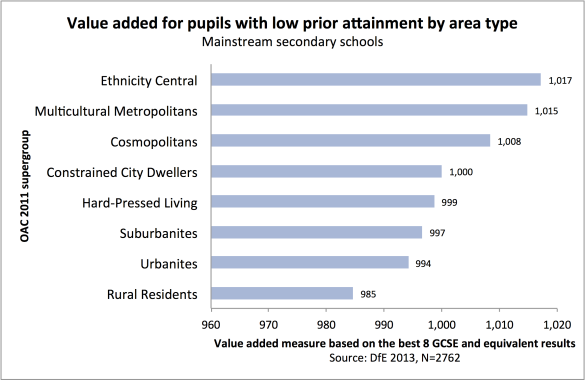This is an extended version of an article I wrote for the New Statesman, based on analysis I conducted for LKMco.
New analysis of data from the ONS and the Department for Education reveals that educational outcomes vary considerably between different types of area. Pupils attending schools in ethnically mixed, often deprived inner city locations achieve, on average, more than a grade better in every GCSE they sit, compared to those attending schools in more peripheral urban locations. Meanwhile, pupils attending schools in ethnically diverse inner-urban areas progress significantly faster than their rural peers.
Beyond the inner city
The map of educational disadvantage is steadily being redrawn. Until the late 1990s, the focus tended to be on deprived inner city areas – particularly inner London, which consistently came bottom of the regional school league tables in England. In the wake of the City Challenges in the capital, Manchester and the Black Country during the 2000s, alongside high profile urban-focused recruitment schemes, the fortunes of some of our previously struggling inner city schools have been raised, if not transformed. In turn, those working to reduce educational disadvantage are now beginning to shift their attention away from deprived inner city areas to new contexts. As Ofsted’s 2013 Access and Achievement report argues, “the areas where the most disadvantaged children are being let down… are no longer deprived inner city areas, instead the focus has shifted to deprived coastal towns and rural, less populous regions of the country.”
Beyond deprivation
This transition away from the inner city reflects a wider shift in education research: away from a narrow focus on deprived areas, towards particular types of deprived area. The Index of Multiple Deprivation (IMD) has become a staple tool when it comes to describing how social outcomes – from educational attainment to wellbeing – are linked to particular neighbourhood contexts. However, the IMD ultimately classifies areas along a single dimension (their level of deprivation) and this is where an alternative, but little used, method of classifying areas has a distinct advantage.
Rather than defining areas as simply more or less deprived, the Output Area Classification defines a given area as belonging to one of eight different ‘area types’, based on a host of Census data – from the age of residents, to the types of homes they live in, to the types of jobs they do. The real power of this area typology is that it distinguishes between deprived central London and the deprived fringes of Southampton; between the affluent suburbs of south Manchester and the affluent villages of the home counties. OAC’s eight main area types range from Cosmopolitans and Ethnicity Central, which cover the vast majority of London’s spatial area, to Constrained City Dwellers and Hard-Pressed Households which constitute a large proportion of places like Basildon, Plymouth and Sunderland.
From the perspective of education research, the OAC allows us to explore how educational outcomes vary between a range of different spatial contexts – some of which may have similar levels of deprivation. Merging the 2011 OAC with 2013 GCSE attainment data from the Department for Education reveals that educational outcomes vary significantly between different types of area, and not just because they’re more or less deprived.
How diverse urban schools the lead the pack
Pupils attending schools in cosmopolitan areas outperform those in hard-pressed areas by the equivalent of almost 1.5 grades in every GCSE they sit. This is despite the fact that cosmopolitan areas are often highly deprived. In fact, the cosmopolitan inner-urban advantage is so sizeable that the performance of schools in the most deprived cosmopolitan areas is broadly in line with the performance of schools in the least deprived places in all other areas of the country:

Meanwhile, students attending schools in the most ethnically diverse areas make the most progress at school, while those in rural areas make the slowest progress. This disparity opens up further still amongst pupils with low prior attainment:

These data demonstrate that when it comes to area-based variation in educational outcomes, it’s more useful to talk in terms of different types of area than simply ‘more or less deprived’ areas. While on average results are better in less deprived areas, ethnically diverse inner-urban areas come top of the pile for attainment and pupil progress, and by some distance, despite being some of the most deprived areas of the country.
Looking for explanations
Opportunities and aspirations
Recent research based on data from the Understanding Society survey shows that young people from inner-urban, more ethnically mixed areas of deprivation are between 2 and 5 times as likely to have aspirations for professional, managerial and technical jobs as those from outer-urban, less mixed areas of deprivation. There are well-documented links between aspirations and attainment: higher occupational aspirations in more ethnically mixed inner urban areas could well be driving higher attainment. But this begs the question: what is causing these area-level differences in aspiration? Higher aspirations in more mixed, urban areas could be linked to the more dynamic, higher-skill labour markets that tend to be concentrated in inner cities. Some suggest that aspirations in inner city areas might also be bolstered by the concentration of universities in these locations. However, educational aspirations (to go on to college and university) are no lower in hard pressed areas at the edge of cities than in multicultural inner urban areas.
Forms of parental support
Data from Understanding Society show that young people from less mixed, outer urban areas of deprivation are the most likely to feel broadly supported by their family, and around 85% of young people from all area types feel their parents are interested in how they do at school. However, when it comes to the practical ways in which parents offer support for their children’s education, differences begin to open up. Around 40% of parents in inner city and multicultural areas help with homework almost every day, compared to around 30% elsewhere, and dipping to around 25% in deprived, traditionally white working class areas. So parents in some types of area appear to be less able to support their children’s education, even if they support them in their lives more broadly and hold a strong desire for them to do well at school.
Redrawing the map
It seems that those working to tackle educational disadvantage are right to be expanding their horizons beyond the inner city, and beyond simple distinctions between more and less deprived areas. However, talking in terms of ‘coastal towns’ and ‘rural regions’ is unnecessarily vague when we have access to data that allow us to identify the specific types of area where educational outcomes appear to be weakest. Paying more attention to specific local contexts also puts us in a better position to understand the conditions that produce such large disparities in educational outcomes between different neighbourhoods.
